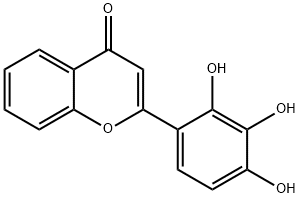2-D08
Synonym(s):2′,3′,4′-trihydroxy-flavone;2-(2,3,4-Trihydroxyphenyl)-4H-1-Benzopyran-4-one
- CAS NO.:144707-18-6
- Empirical Formula: C15H10O5
- Molecular Weight: 270.24
- Update Date: 2023-06-08 09:01:58

What is 2-D08?
The Uses of 2-D08
2-D08 has been used as a small ubiquitin-like modifier (SUMO)ylation inhibitor.
Biological Activity
2-d08 (2’,3’,4’-trihydroxyflavone) is a sumoylation inhibitor.protein sumoylation is a dynamic posttranslational modification involved in various biological processes, such as cellular homeostasis and development. sumoylation has been reported to play a key role in cancer, though so far there are few small molecule probes available.
Biochem/physiol Actions
2-D08 is a potent and cell-permeable inhibitor of sumoylation that block the transfer of SUMO (small ubiquitin-like modifier) from the E2 enzyme (Ubc9) thioester conjugate to the substrate.
in vitro
2-d08 was identified as a cell permeable, mechanistically unique inhibitor of protein sumoylation. this compound was found to be able to block sumoylation of topoisomerase i in two different cancer cell lines when co-dosed with camptothecin. in addition, futher analyses indicated that 2-d08 inhibited sumoylation via preventing transfer of small ubiquitin-like modifier (sumo) from the ubc9-sumo thioester to the substrate without affecting sumo-activating enzyme e1 (sae-1/2) or e2 ubc9-sumo thioester formation, a mechanism of action that was unprecedented before [1]. moreover, it was found that 2-d08 at 100 μm could effectively inhibit 10 μm camptothecin induced topoisomerase i sumoylation in breast cancer without affecting overall cellular protein ubiquitinations [2].
References
[1] kim ys, keyser sg, schneekloth js jr. synthesis of 2',3',4'-trihydroxyflavone (2-d08), an inhibitor of protein sumoylation. bioorg med chem lett. 2014 feb 15;24(4):1094-7.
[2] kim ys, nagy k, keyser s, schneekloth js jr. an electrophoretic mobility shift assay identifies a mechanistically unique inhibitor of protein sumoylation. chem biol. 2013 apr 18;20(4):604-13.
Properties of 2-D08
| Boiling point: | 517.9±50.0 °C(Predicted) |
| Density | 1.548±0.06 g/cm3(Predicted) |
| storage temp. | 2-8°C |
| solubility | ≥74.6 mg/mL in DMSO; ≥1.76 mg/mL in EtOH with gentle warming and ultrasonic; insoluble in H2O |
| pka | 7.45±0.40(Predicted) |
| form | powder |
| color | white to beige |
Safety information for 2-D08
| Signal word | Warning |
| Pictogram(s) |
 Exclamation Mark Irritant GHS07 |
| GHS Hazard Statements |
H302:Acute toxicity,oral |
| Precautionary Statement Codes |
P280:Wear protective gloves/protective clothing/eye protection/face protection. P305+P351+P338:IF IN EYES: Rinse cautiously with water for several minutes. Remove contact lenses, if present and easy to do. Continuerinsing. |
Computed Descriptors for 2-D08
New Products
4-AMINO-TETRAHYDRO-PYRAN-4-CARBOXYLIC ACID HCL 4-Aminotetrahydropyran-4-carbonitrile Hydrochloride (R)-3-Aminobutanenitrile Hydrochloride 3-(dimethylamino)-9,10-dimethoxy-1,3,4,6,7,11b-hexahydro-2H-pyrido[2,1-a]isoquinolin-2-one Iminostilbene 1,4-Dioxa-8-azaspiro[4.5]decane 5-Bromo-2-nitropyridine 4-(Dimethylamino)tetrahydro-2H-pyran-4-carbonitrile SODIUM AAS SOLUTION ZINC AAS SOLUTION BUFFER SOLUTION PH 10.0(BORATE) GOOCH CRUCIBLE SINTERED AQUANIL 5 BERYLLIUM AAS SOLUTION Methylcobalamin (vitamin B12) SODIUM METHYL PARABEN Diclofenac Sodium SODIUM VALPROATE Racecadotril XANTHAN GUM 5-Fluoro-2-iodo-3-methylphenol 4-(Cyanomethyl)-1-piperidineacetamide 6-Bromo-2-iodo-4-methyl-3-pyridinamine 5-Amino-3-bromo-2-chlorobenzeneacetic acidYou may like
-
 2-D08 CAS 144707-18-6View Details
2-D08 CAS 144707-18-6View Details
144707-18-6 -
 1823754-06-8 98%View Details
1823754-06-8 98%View Details
1823754-06-8 -
 2-Chloro-5-(iodomethyl)pyrimidine 2268818-88-6 98%View Details
2-Chloro-5-(iodomethyl)pyrimidine 2268818-88-6 98%View Details
2268818-88-6 -
 2092793-98-9 98%View Details
2092793-98-9 98%View Details
2092793-98-9 -
 1360944-55-3 7-Methoxy-1H-indol-5-amine 98%View Details
1360944-55-3 7-Methoxy-1H-indol-5-amine 98%View Details
1360944-55-3 -
 2090480-14-9 98%View Details
2090480-14-9 98%View Details
2090480-14-9 -
![1-Methyl 2-bromo-5-[(1-carboxy-1-methylethyl)amino]benzoate 1651844-56-2 98%](https://img.chemicalbook.in//Content/image/CP5.jpg) 1-Methyl 2-bromo-5-[(1-carboxy-1-methylethyl)amino]benzoate 1651844-56-2 98%View Details
1-Methyl 2-bromo-5-[(1-carboxy-1-methylethyl)amino]benzoate 1651844-56-2 98%View Details
1651844-56-2 -
 176445-77-5 4-(Dimethylamino)tetrahydro-2H-pyran-4-carbonitrile 98+View Details
176445-77-5 4-(Dimethylamino)tetrahydro-2H-pyran-4-carbonitrile 98+View Details
176445-77-5